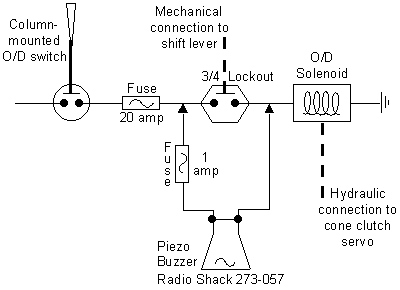Just a Simple Wrench
 by Ann & Jake Snyder
by Ann & Jake Snyder
Keeping What You Have
We have always been very happy with the overdrive units on our MGBs. These are, to us at least, absolutely essential for the freeway and tollway driving we do year round: Staying with traffic and out of harmís way can be achieved at significantly lower revs with overdrive engaged. The difference in some instances has been between 3200 rpm with overdrive engaged compared to 4000 rpm in direct drive. Useful numbers to remember are the conversion factors of rpm to mph -18 mph per 1000 rpm in direct drive and 22 mph per 1000 rpm in overdrive. Both conversions assume minimal slip in the clutch assembly and tire diameters fairly close to the original 165X14 Dunlop factory originals. While we do not condone operating a vehicle in excess of the statutory speed limits, these are legal speeds in some parts of Michigan, and have been occasionally observed in and about Chicago. We have two practical reasons for preferring lower revs during operation. The first is that our cars tend to use oil at an appreciably higher rate at higher revs. The second is that noise and vibration are less at the lower revs, which translates into a shorter refractory period in the driver and passenger until the ground stops vibrating after we stop and get out following a couple of hundred hard miles.
Maintenance is simple: change the oil and filter once a year and keep it full of oil at all times to eliminate unnecessary wear on the cone clutch. Recommended use is simple, also: accelerate the car to the desired cruising speed, and switch in the overdrive. Accelerating in overdrive is possible, but any slip in the cone clutch brings closer the time when the cone clutch must be replaced. This part costs several hundred dollars and requires dismantling the gearbox to fit the new part.
Unfortunately, abuse of the overdrive is too easy to accomplish. All the driver has to do is forget that overdrive was switched in after the last toll booth twenty minutes ago. Pulling out from the next toll both without switching out the overdrive function means that acceleration to cruising speed will automatically occur with overdrive engaged. On the oldest MGBs with the three-synchro gearboxes, there is a set of complex controls to keep this from happening, reputedly because the brass cone clutches in these units are extremely fragile. (We have never seen a 3-synchro-overdrive ourselves, but vendors do list parts, so they must be around someplace.) The chrome-bumper 4-syncro overdrives give the possibility of accelerating in 3rd-plus-overdrive, which is worse than accelerating in 4th-overdrive due to the greater torque. Accelerating in 4th-plus-overdirve is the only abuse option with the rubber-bumper units. Our tendency, upon discovering that overdrive was still switched in and we were accelerating, was to switch out immediately. We later heard that this can cause catastrophic gear failure if acceleration is sufficiently spirited. If you have forgotten to switch out, at least ease up a little before disengaging overdrive operation.

Fortunately, all the problems associated with improper use of the overdrive can be eliminated for less than ten dollars with no significant wiring changes on the chrome bumper 4-synchro units. All that is required, other than an attitude adjustment on the part of the driver, is a loud alarm connected in the circuit, so that the alarm receives power from the actuating switch. When the car is in 3rd or 4th, the shift lever closes the 3-4 O/D lockout switch located on the gearbox. Pulling back on the right column-mounted control gives power to the circuit, and the current flows through the column switch, the gearbox switch and the overdrive solenoid, where a small ball bearing gets slammed across a pressure relief port, thus directing 400 psi oil pressure into the cone clutch servo, which causes the overdrive gears to engage.
Now, assume the driver left the switch on the column in the pulled-back position. As soon as the car is shifted out of 4th gear, current flows through the column switch, but cannot get through the 3-4 O/D lockout, which is now open. Instead the current goes through the piezo-electric buzzer and into the overdrive solenoid. But the amount of current (a twentieth of an amp) is not nearly enough to operate the overdrive solenoid, which requires three or four amps. So the little ball bearing stays in place, and the only result is the raucous shrieking of the piezo-electric buzzer, which can generate 90 to 100 decibels right in front of the driver under the dash. (Mounting the alarm on the gearbox or engine bay is mechanically simpler, but it may then go unnoticed.)
Construction is straight-forward - use a Radio Shack buzzer similar to 273-057. Use a one-amp fuse in the alarm circuit, and add the twenty amp fuse that the factory forgot in the overdrive circuit. Yellow is the main color for any extra wire that is needed, and the connections should be within the mechanicís ethical frame of reference. (We solder ours and use only the original bullets and Lucar connectors). The buzzer may be mounted with a screw or with silastic (silicone bathtub caulk).
Unfortunately, the designers chose to change the relative electrical positions of the mechanical switch and the 3-4 O/D lockout when the mechanical switch was moved from the column to the shift knob. They also took away the option of abusing the overdrive in 3rd gear by activating the O/D lockout only in 4th gear. Using this alarm circuit on rubber bumper overdrive units will require changing the relative electrical positions of the two switches in the circuit back to that used in the earlier cars.
Useful references include the wiring diagram in the ownerís manual for your carís year, as well as Bentley and Haynes. Mr. Twistís UML Technical Booklet ($30 direct from UML) is essential for electrical systems. We have included a diagram of the alarm circuit, with comments.
There is one more benefit of this overdrive alarm. With selection of an adequately offensive piezo-electric buzzer that cannot be ignored, you may lend your car to anyone with confidence that the overdrive will be used properly.
 
|


 by Ann & Jake Snyder
by Ann & Jake Snyder
